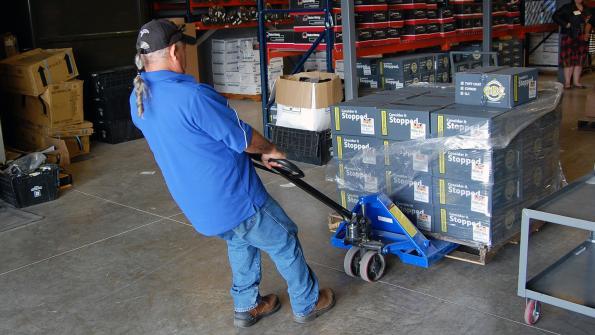How to prevent non-driving injuries: Technology, culture and 'jackhammering'
Submitted by Bill on
Aug 26, 2016 Larry Kahaner | Fleet Owner
Truck drivers have the highest number of nonfatal injuries and illnesses that require days off from work across all U.S. occupations. But if you think it's mainly from road accidents, you're wrong.
"Injuries that are most likely to cause truckers to miss work result from slips, trips and falls, followed by overexertion," notes a recent Bureau of Bureau of Labor Statistics blogthat highlights 2014 statistics, which are the latest figures available (2015 figures will be published in December.)
How do truckers overexert themselves? "Pushing and pulling containers; lifting heavy items while loading and unloading the truck; and getting in and out of such a large vehicle routinely are all ways that drivers can easily overdo it on the job," the blog notes.
Although carriers emphasize road safety – and the lessons are paying off in lower crash rates - more needs to be done to prevent injuries caused by non-driving activities, say fleet safety experts.
Unfortunately, the job's main activity – sitting behind the wheel – is often to blame. "Any time you have a worker in a sedentary environment that moves drastically or rather quickly into a fairly aggressive or heavy physical environment, and if they haven’t stretched appropriately, or they haven’t given their bodies an opportunity to warm up, there’s an extreme risk of having injuries as a result," says Christian Tardi, Workplace Health and Safety Leader at Bison Transport in Winnipeg, Manitoba. The carrier offersvideos on how to reduce injuries.
Many drivers hurt themselves leaving the cab even though they know the correct procedure to minimize injuries. "Drivers learn the three points of contact in training schools, right at the start, and you hear it throughout your career," says Eric Roeder, Bison's Driver Development Instructor. "But you tend to think your body can take more than it actually can. So you think, 'Oh, I’ll just swing out of here and jump down.' And then you throw in winter time, with some slippery steps mixed in, and the potential for injury is pretty high."
Adds Tardi: "It's often complacency. You’ve got a driver who's been in the industry for a number of years thinking that he’s invincible to injury, because he knows how to get in and out of his truck. Then he feels the need to get out of the cab quickly. Unfortunately, nine times out of ten it results in injury."
What helps drivers avoid injuries?
One answer is industry focus. "I don’t think there’s been a great focus on driver safety outside of the cabin as there has been for motor vehicle accidents and critical events. And that’s industry wide," says Tardi. He notes that the construction industry has done an excellent job lowering workplace injuries in a workplace traditionally considered highly dangerous. "There's been construction [safety] associations all over Canada for probably 15 years now, whereas in our industry, we are just getting these associations up and running now. Construction [injury rates] used to be much higher than the transportation industry, but you’ve seen construction take a huge dive with their workplace injury statistics over the course of the last ten years. Hopefully, we [in trucking] can start trending in that direction."
Tardi and Roeder say that while trucking has seen big steps in crash reduction due to technology (lane departure warning devices, for example) some injury prevention devices are coming on line, too. "For example," Roeder says, "in some of our latest trucks, the handles for climbing in and out of the truck are bright yellow. They’re very noticeable and highly visible and likely will help reduce injuries. [With regular handles] sometimes drivers just don’t see them and grab onto the side of the door, or whatever, which can often not be an effective handle." He also says that drivers are becoming more amenable to wearing reflective vests and traction devices for shoes. "I can recall in my younger days when I was driving, the general attitude was that there’s no way anybody would wear a safety vest. That was for weaklings, and it just wasn’t considered macho or acceptable. Now when you look around, it’s become pretty acceptable to wear safety vests, to the point where I’ve seen people in line outside the bar wearing it." He adds: "I think it started with work boots, when it became acceptable to wear work boots. They have become part of regular fashion, and now we’re seeing it with safety vests."
The same can be said of safety glasses, Tardi notes. "Back in the day, when you wore safety glasses, they were these huge honking bulky things that hurt your face when you put them on. Now you can get wraparound glasses, that are comfortable, so that’s helped a lot as well."
Adds Roeder, "Slowly, some things are already starting to be engineered that will help. But in the end, it really comes down to informing the driver, and what's sometimes referred to in safety training as 'jackhammer technology.' You just have to keep hammering [education, awareness and training] into workers, because human nature is to take the easy way out."
Along with this, carriers must support a culture of accountability and consistency, says Tardi. "If you’re not holding people accountable for their actions, and you’re not insistent with that, you’re not going to get drivers' buy-in."
More Recent News Stories








